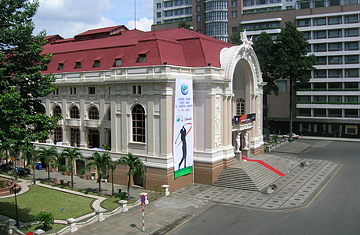
The Opera House in Saigon.
In a city with two names in a country that, at least for Americans, bespeaks infamy, downtown Saigon — present-day District 1 of Ho Chi Minh City — is a bustle of raucous commerce that attacks the senses. And yet, for many of its visitors, the prized memento of the city is a cheap, pirated copy of Graham Greene's The Quiet American, purchased along the Dong Khoi quarter (formerly the rue Catinat) where the booksellers say it remains one of their hottest titles. It is a simple tale of tangled love, murder and espionage in the dying days of the French colonial era, but its descriptions and asides about Saigon's streets, cafes, hotels and lifestyle continue to inspire foreign romantics. Much of Greene's Saigon still stands in all of its decadence, and tourism based on his take on the city is a growth industry. Guidebooks have begun offering walking tours of some of the book's locations, while the popular Literary Traveler web site offers a Graham Greene how-to.
On a recent Sunday, with skies still gray from a lingering typhoon, I arrived at the Hotel Continental with a sense of modesty and whist, much like Alden Pyle, the book's title character. Both hotel and the adjacent Saigon Opera House retain their eggshell white facades and arches, symbolizing old Vietnam in a city chockfull of billboards for Kentucky Fried Chicken and Louis Vuitton. The Continental is where Greene's protagonists, Pyle and British journalist Thomas Fowler, meet for the first time, before they are divided by politics and their common love for Phuong, a Vietnamese girl. Over morning tea at the Continental's outside café, which is no longer there, the characters exchange niceties against the backdrop of Saigon's bustling foot traffic. For enthusiasts, a nightcap or aperitif at a window-side table in the Continental's Venezia Restaurant will have to do.
I had managed to secure Room 214, much sought after by aficionados as the flat where Greene supposedly stayed when writing the book. The sight of a dark wooden desk and chair with a blood velvet cushion were reassuring as I entered the $129-per-night corner suite; the room felt touched by a writer's hand, as if inspiration flowed as freely as the complimentary shampoo and conditioner in the suite's bathroom. Most important, here was the spacious balcony overlooking the opera house and the square below — a view that would have been ideal for catching Pyle's botched terrorist plot or Fowler's railing against the American press corps.
Another haunt of the author was the Majestic Hotel on the banks of the Saigon River, where the rooftop bar still thrives much as it did when Greene wintered in Vietnam during the 1950s. Recently, the hotel became the first state-owned property to earn the illustrious five-star rating. That has simply made a steak and fine wine, as enjoyed by Greene, cost as much as $50. Also intact were the sights taken in by Fowler on a day trip to the Cao Dai Holy See Temple, some 60 miles from downtown Saigon. The route to the temple still passes the iconic verdant rice paddies that prompts Fowler to muse, "Where the gold harvest was ready the peasants in their hats like limpets winnowed the rice against little curved shelters of plaited bamboo."
The Quiet American may not be Greene's most famous novel, but it is arguably his most controversial. At the time of its publication in 1955, some panned it as an anti-American diatribe because of its suggestion that the U.S. was bankrolling puppet governments in the third world. That much may now be part of the public record, but still, the release of the 2002 movie adaptation starring Michael Caine was delayed for several months out of concern for giving offense in the wake of 9/11. And then there were the lesser transgressions, such as the amount of opium Greene had his main character smoke. Although opium is no longer as prevalent in Vietnam as it once was, decorative pipes modeled after the ones Fowler would have used are sold in various curio shops. I contented myself with breathing deep on the air of history, checking out of the Continental with an air of self-satisfied complacency. Unlike Fowler, who at the end of the book is in a pensive mood: "I thought of the first day and Pyle sitting beside me at the Continental, with his eye on the soda-fountain across the way. Everything had gone right with me since he had died, but how I wished there existed someone to whom I could say that I was sorry." I can't say I was.
